In 1998 Medic met Per Ödman through our mutual friend Mike Gillen, the three of us members of Vietnam Veterans Against the War. Per’s story relates his extraordinary resilience during and after his time at war. This article first appeared in the Spring 2016 issue of The Veteran, newspaper of Vietnam Veterans Against the War.
I was born in Sweden in 1943. My father was highly educated, and very successful in his field. I, however, was pretty much the opposite—I was an immature loser, and I failed to graduate from Swedish high school. After working in mines and doing odd jobs I was ordered to enter the Swedish Army in the fall of 1965. My feelings about serving were very mixed. It turned out that I really liked it. For the first time in my life I was the best at something. I was a machine gunner, and I was my platoon commander’s favorite soldier. Towards the end of my service I decided, just for the hell of it, to fight as an infantryman in Vietnam; for the US or its allies. If they would not take me, my not-so-realistic plan was to approach North Vietnam.
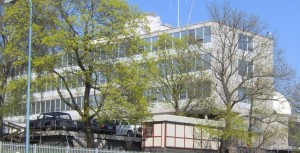 My first step was to visit a US army colonel who served as a military attache at the US embassy in Stockholm. He thought my idea was a great. “We need guys like you in Vietnam!” he said. My parents thought it was a horrible idea, and my father quickly got me hired as an assistant to Swedish geologists who prospected for iron ore in the wild mountainous rain forests in Liberia. I spent an adventurous, colonial era-like year in tropical West Africa, and in April 1967, I visited the US Embassy in Monrovia, the capitol of Liberia, where I applied for a green card.
My first step was to visit a US army colonel who served as a military attache at the US embassy in Stockholm. He thought my idea was a great. “We need guys like you in Vietnam!” he said. My parents thought it was a horrible idea, and my father quickly got me hired as an assistant to Swedish geologists who prospected for iron ore in the wild mountainous rain forests in Liberia. I spent an adventurous, colonial era-like year in tropical West Africa, and in April 1967, I visited the US Embassy in Monrovia, the capitol of Liberia, where I applied for a green card.
On May 25, with my new green card, I flew one way to JFK airport in the United States. After checking into a hotel in midtown Manhattan, I went to the recruiting station in Times Square, where I talked to the Army recruiter about airborne and rangers school, and to the Marine’s about a two-year enlistment. After pondering it for a week, I swore to serve two years in the USMC.
At 3am the next morning I was “welcomed” to Parris Island and spent the next thirteen 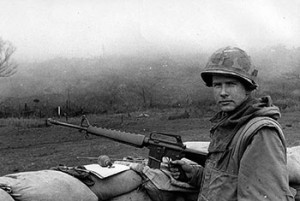 hellish weeks in training. As a gung ho Marine 0311 (rifleman) I arrived in Da Nang on Christmas Eve 1967—what a X-mas present! A few days later I arrived at my unit, the 26th Marines, who held Khe Sanh. I was assigned to 2nd Platoon, Delta Company, 1st Battalion. They called me “Swede.” On January 20, 1968, Khe Sanh came under siege. While it’s true I was a gung ho Marine, I was not really fighting for the US; I was fighting for myself and my platoon. The killing on both sides made me quite aware how ambivalent I was about the US winning the war. After 77 very tough days, MACV declared the siege over, and an overwhelming victory. But battle casualties remain controversial. We lost as many as 1,000 KIA; the NVA as many as 10,000.
hellish weeks in training. As a gung ho Marine 0311 (rifleman) I arrived in Da Nang on Christmas Eve 1967—what a X-mas present! A few days later I arrived at my unit, the 26th Marines, who held Khe Sanh. I was assigned to 2nd Platoon, Delta Company, 1st Battalion. They called me “Swede.” On January 20, 1968, Khe Sanh came under siege. While it’s true I was a gung ho Marine, I was not really fighting for the US; I was fighting for myself and my platoon. The killing on both sides made me quite aware how ambivalent I was about the US winning the war. After 77 very tough days, MACV declared the siege over, and an overwhelming victory. But battle casualties remain controversial. We lost as many as 1,000 KIA; the NVA as many as 10,000.
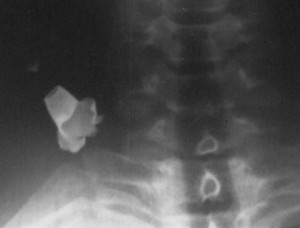 After the siege lifted, my battalion did sweeps in de-populated areas in the central parts of I Corps. We hunted the NVA, and they hunted us. On June 7, my platoon walked into an ambush, and I was hit by multiple AK47 bullets, which had lost some of their velocity, surely not due to my flak jacket—I had thrown it away. The bullets lodged in my left lung and the back of my neck.
After the siege lifted, my battalion did sweeps in de-populated areas in the central parts of I Corps. We hunted the NVA, and they hunted us. On June 7, my platoon walked into an ambush, and I was hit by multiple AK47 bullets, which had lost some of their velocity, surely not due to my flak jacket—I had thrown it away. The bullets lodged in my left lung and the back of my neck.
[see Addendum regarding corrections to the paragraphs immediately above and below.]
A third bullet shattered as it hit something hard, likely the 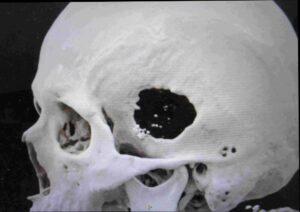 muzzle of my M16. Ten pieces of this bullet (you can count them on the CAT scan) hit my left temple with the force of a sledge hammer, tearing a hole in my skull the size of a silver dollar, and causing bone fragments to lodge in the outer part of my brain. The bullet fragments lodged one to two inches deep in my brain, and one in the center of it. I was conscious long enough to know that I was dying.
muzzle of my M16. Ten pieces of this bullet (you can count them on the CAT scan) hit my left temple with the force of a sledge hammer, tearing a hole in my skull the size of a silver dollar, and causing bone fragments to lodge in the outer part of my brain. The bullet fragments lodged one to two inches deep in my brain, and one in the center of it. I was conscious long enough to know that I was dying.
Who saved my life? Our corpsman? Another Marine? Twenty-five years later I met my platoon commander for the first time since the incident: “Are you fucking alive?!” he exclaimed. The medevacs were coming to pick up the wounded, but when he saw me laying next to the KIAs with an ashen face and covered in blood, he knew I was dead. Due to our heavy losses he became our company commander the following day, in the confusion losing track of his men. What saved me was some one’s decision to haul me on board a medivac chopper. It was that simple.
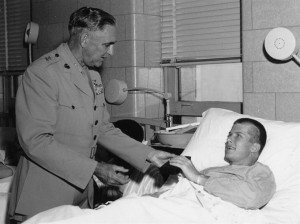 Initially my right side was completely paralyzed, but to make a long story short, two and a half months later I was back in Sweden running cross-country—slowly. The Marines rated me 90% disabled and retired me in May 1969. The VA rated me 100% disabled. I decided to study architecture in Washington, DC, but after a couple of years I moved to New York to study photography. On the surface my life in Washington had seemed normal—I had pals and girlfriends, but my move to New York in 1971 exposed me to an anti-war world that wholly I embraced. I woke up from my emotional and political torpor, joined Vietnam Veterans Against the War, partook in their rap groups, and at VVAW’s demonstrations I vented my hatred of the war. I was a “reborn” Marxist.
Initially my right side was completely paralyzed, but to make a long story short, two and a half months later I was back in Sweden running cross-country—slowly. The Marines rated me 90% disabled and retired me in May 1969. The VA rated me 100% disabled. I decided to study architecture in Washington, DC, but after a couple of years I moved to New York to study photography. On the surface my life in Washington had seemed normal—I had pals and girlfriends, but my move to New York in 1971 exposed me to an anti-war world that wholly I embraced. I woke up from my emotional and political torpor, joined Vietnam Veterans Against the War, partook in their rap groups, and at VVAW’s demonstrations I vented my hatred of the war. I was a “reborn” Marxist.
During the nineties I revisited Vietnam four times—to see the country and the people. On 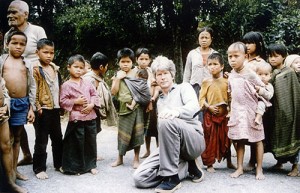 each trip I went to Hanoi to meet my former enemies. We drank much beer, ate a lot of weird food, and with the help of an interpreter told each other war stories.
each trip I went to Hanoi to meet my former enemies. We drank much beer, ate a lot of weird food, and with the help of an interpreter told each other war stories.
In April 1994, partly for adventure and partly for reconciliation, I did a four-day-long climb of Fan Si Pan, at 10,312 feet Vietnam’s tallest mountain, together with Nguyen Thien Hung, my guide. After the two first hours of steadily climbing, Hung and I took a break. Using pencil and paper, gestures and facial expressions, and uttering sounds, I learned that Hung had fought the Americans since 1967. In fact, as a 2nd Lieutenant, and a tank commander, he had participated in the final route of the ARVN, and on April 30, 1975 had victoriously driven his tank into Saigon. In 1983 Hung left the People’s Army to return to his home in the mountainous north western corner of Vietnam.
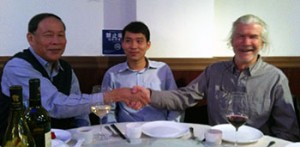 As it turned out, my climb turned out to be more of a reconciliation than I had thought. Two of the nights we lay huddled against each other for body heat, belly against rump. Our damp wool blanket barely cut the freeze.
As it turned out, my climb turned out to be more of a reconciliation than I had thought. Two of the nights we lay huddled against each other for body heat, belly against rump. Our damp wool blanket barely cut the freeze.
Last December, I had the great pleasure of meeting another of my former enemies, this time in New York City. Captain Nguyen Van Rinh, who, at 27 years old, commanded one of the NVA’s dozens of well dug in camouflaged batteries that encircled and fired thousands of high explosive shells on the Marines besieged at Khe Sanh.
Somehow, he survived the enormous firepower of our 105s and B-52s, and continued fighting the Americans, the ARVN after the US fled Vietnam, and on April 30, 1975, Captain Van Rinh and his comrades celebrated North Vietnam’s victorious end of the war. As did Vietnam Veterans Against the War.
After a career in the Army, the former captain retired as a colonel general, the People’s Army 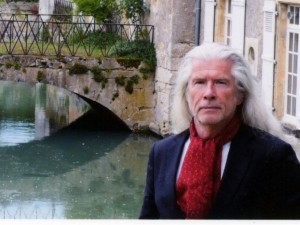 second highest rank, and continued his service to Vietnam as Deputy Minister of Defense. He is nowadays President of VAVA (Vietnam Association for the Victims of Agent Orange). We heartily shared a meal in a Chinese restaurant in Midtown, and with the help of his interpreter we warmly shared some of our experiences of trying to kill each other.
second highest rank, and continued his service to Vietnam as Deputy Minister of Defense. He is nowadays President of VAVA (Vietnam Association for the Victims of Agent Orange). We heartily shared a meal in a Chinese restaurant in Midtown, and with the help of his interpreter we warmly shared some of our experiences of trying to kill each other.
_________________________
Top photo: At Madison Ave and East 27th Street Per Ödman, Michael Hayes at center, Ben Chitty at right await their turn to march up New York’s 5th Avenue in the 2011 Veterans Day parade.
Per Ödman restores old houses and lives in the Vinegar Hill section of Brooklyn, NY. He also spends time in France and travels widely.
ADDENDUM
In October 2023 Medic received the email below (lightly edited for clarity) from Per Ödman regarding new and more accurate information concerning his wounds.
I was wounded on 7 June 1968. I secretly took, during December 1968 in my Navy neurologist’s office in Bethesda, photographs of four x-rays, which had been taken in the Naval Field Hospital in Da Nang, very soon after I had been wounded. I also have copies of five 2007 CT scans. In January 2023 I asked my neurologist to take CT scans of my skull to see if the physical state of my brain had worsened since 2007. “Not much,” he said. It wasn’t until a few days ago that I figured out how to see those scans in MyChart.
These new scans are more technically advanced than those made in 2007. But even now, in spite of these images, and the Navy surgeon’s somewhat unclear medical report of 10 June 68, there are still things I don’t know, and never will.
I do know that a damaged, low velocity bullet, together with a very small piece of it, entered the left front of my neck. It penetrated about 1 ¾ inches with enough force to lacerate the inner jugular vein, where the bullet came to a stop. The profuse bleeding of the wound was life-threatening. Within minutes after having been unloaded off the chopper at the Naval Field Hospital in Da Nang, my neck had been x-rayed, and the surgeons then successfully repaired the vein.
The surgery was straightforward. The scar is about one inch long. The ricocheted, low velocity bullet(s) which had entered my upper left chest caused hemopneumothorax [blood and air in the lungs], which required the insertion of a chest tube. A 6 inch incision was made to remove the bullet(s).
What I now also know is that nine—one quite large—pieces of shrapnel penetrated the back of my neck without causing severe damage. The Da Nang surgeons decided not to remove them. From what I remember, my skull, neck and chest wounds happened in quick succession. How and when the shrapnel—from a mortar, artillery, friendly fire—hit the back of my neck, I don’t know. The possibilities are endless.
I’ll never know what hit the left temporal region of my skull. Since most of the shrapnel pieces form a more or less straight line from the left front towards the center of the brain, it was not a grenade. However, could pieces of grenade shrapnel have been funneled to travel in a line while retaining their velocity? And what made at least two, maybe four pieces travel in two different directions? Anyway, the 2023 CT scans show that at least seven pieces, maybe ten, are lodged in my brain.
The biggest piece, about 1/2 inch in diameter, is 3 inches deep in the tectum, the very center of my brain. Five to seven pieces of shrapnel are located to the rear of the left eye socket between the skin and the partially exposed brain.
In 1968 at the Naval Hospital in Bethesda, Maryland the surgeons advised me to let them install a platinum skull plate. I declined. Was I overly optimistic? I didn’t want to continue being an inpatient. One day while at Bethesda I got a manila envelope containing my intact wallet, dog tags and Rolex watch (I’d made good money in Liberia) which were covered with dry blood.
In my article in VVAWs The Veteran I erroneously wrote that the bullet which had entered the left front of my neck had been lodged in the rear of my neck. I think I know why I wrote that. I was in France in 2016 when VVAW asked for articles about what guys had done fifty years earlier. Though I had x-rays and CT scans I wrote the article without enough written documentation. (I did have a photocopy of the first telegram to my parents, delivered by a uniformed Navy captain: “HIS CONDITION WAS SERIOUS WITH HIS PROGNOSIS POOR”.) Somehow, I subconsciously misinterpreted that the bullet had gone thru most of my neck. But that would have killed me.

How Swede It Is: The Death and Life of Per Ödman
In 1998 Medic met Per Ödman through our mutual friend Mike Gillen, the three of us members of Vietnam Veterans Against the War. Per’s story relates his extraordinary resilience during and after his time at war. This article first appeared in the Spring 2016 issue of The Veteran, newspaper of Vietnam Veterans Against the War.
I was born in Sweden in 1943. My father was highly educated, and very successful in his field. I, however, was pretty much the opposite—I was an immature loser, and I failed to graduate from Swedish high school. After working in mines and doing odd jobs I was ordered to enter the Swedish Army in the fall of 1965. My feelings about serving were very mixed. It turned out that I really liked it. For the first time in my life I was the best at something. I was a machine gunner, and I was my platoon commander’s favorite soldier. Towards the end of my service I decided, just for the hell of it, to fight as an infantryman in Vietnam; for the US or its allies. If they would not take me, my not-so-realistic plan was to approach North Vietnam.
On May 25, with my new green card, I flew one way to JFK airport in the United States. After checking into a hotel in midtown Manhattan, I went to the recruiting station in Times Square, where I talked to the Army recruiter about airborne and rangers school, and to the Marine’s about a two-year enlistment. After pondering it for a week, I swore to serve two years in the USMC.
At 3am the next morning I was “welcomed” to Parris Island and spent the next thirteen hellish weeks in training. As a gung ho Marine 0311 (rifleman) I arrived in Da Nang on Christmas Eve 1967—what a X-mas present! A few days later I arrived at my unit, the 26th Marines, who held Khe Sanh. I was assigned to 2nd Platoon, Delta Company, 1st Battalion. They called me “Swede.” On January 20, 1968, Khe Sanh came under siege. While it’s true I was a gung ho Marine, I was not really fighting for the US; I was fighting for myself and my platoon. The killing on both sides made me quite aware how ambivalent I was about the US winning the war. After 77 very tough days, MACV declared the siege over, and an overwhelming victory. But battle casualties remain controversial. We lost as many as 1,000 KIA; the NVA as many as 10,000.
hellish weeks in training. As a gung ho Marine 0311 (rifleman) I arrived in Da Nang on Christmas Eve 1967—what a X-mas present! A few days later I arrived at my unit, the 26th Marines, who held Khe Sanh. I was assigned to 2nd Platoon, Delta Company, 1st Battalion. They called me “Swede.” On January 20, 1968, Khe Sanh came under siege. While it’s true I was a gung ho Marine, I was not really fighting for the US; I was fighting for myself and my platoon. The killing on both sides made me quite aware how ambivalent I was about the US winning the war. After 77 very tough days, MACV declared the siege over, and an overwhelming victory. But battle casualties remain controversial. We lost as many as 1,000 KIA; the NVA as many as 10,000.
[see Addendum regarding corrections to the paragraphs immediately above and below.]
A third bullet shattered as it hit something hard, likely the muzzle of my M16. Ten pieces of this bullet (you can count them on the CAT scan) hit my left temple with the force of a sledge hammer, tearing a hole in my skull the size of a silver dollar, and causing bone fragments to lodge in the outer part of my brain. The bullet fragments lodged one to two inches deep in my brain, and one in the center of it. I was conscious long enough to know that I was dying.
muzzle of my M16. Ten pieces of this bullet (you can count them on the CAT scan) hit my left temple with the force of a sledge hammer, tearing a hole in my skull the size of a silver dollar, and causing bone fragments to lodge in the outer part of my brain. The bullet fragments lodged one to two inches deep in my brain, and one in the center of it. I was conscious long enough to know that I was dying.
Who saved my life? Our corpsman? Another Marine? Twenty-five years later I met my platoon commander for the first time since the incident: “Are you fucking alive?!” he exclaimed. The medevacs were coming to pick up the wounded, but when he saw me laying next to the KIAs with an ashen face and covered in blood, he knew I was dead. Due to our heavy losses he became our company commander the following day, in the confusion losing track of his men. What saved me was some one’s decision to haul me on board a medivac chopper. It was that simple.
During the nineties I revisited Vietnam four times—to see the country and the people. On each trip I went to Hanoi to meet my former enemies. We drank much beer, ate a lot of weird food, and with the help of an interpreter told each other war stories.
each trip I went to Hanoi to meet my former enemies. We drank much beer, ate a lot of weird food, and with the help of an interpreter told each other war stories.
In April 1994, partly for adventure and partly for reconciliation, I did a four-day-long climb of Fan Si Pan, at 10,312 feet Vietnam’s tallest mountain, together with Nguyen Thien Hung, my guide. After the two first hours of steadily climbing, Hung and I took a break. Using pencil and paper, gestures and facial expressions, and uttering sounds, I learned that Hung had fought the Americans since 1967. In fact, as a 2nd Lieutenant, and a tank commander, he had participated in the final route of the ARVN, and on April 30, 1975 had victoriously driven his tank into Saigon. In 1983 Hung left the People’s Army to return to his home in the mountainous north western corner of Vietnam.
Last December, I had the great pleasure of meeting another of my former enemies, this time in New York City. Captain Nguyen Van Rinh, who, at 27 years old, commanded one of the NVA’s dozens of well dug in camouflaged batteries that encircled and fired thousands of high explosive shells on the Marines besieged at Khe Sanh.
Somehow, he survived the enormous firepower of our 105s and B-52s, and continued fighting the Americans, the ARVN after the US fled Vietnam, and on April 30, 1975, Captain Van Rinh and his comrades celebrated North Vietnam’s victorious end of the war. As did Vietnam Veterans Against the War.
After a career in the Army, the former captain retired as a colonel general, the People’s Army second highest rank, and continued his service to Vietnam as Deputy Minister of Defense. He is nowadays President of VAVA (Vietnam Association for the Victims of Agent Orange). We heartily shared a meal in a Chinese restaurant in Midtown, and with the help of his interpreter we warmly shared some of our experiences of trying to kill each other.
second highest rank, and continued his service to Vietnam as Deputy Minister of Defense. He is nowadays President of VAVA (Vietnam Association for the Victims of Agent Orange). We heartily shared a meal in a Chinese restaurant in Midtown, and with the help of his interpreter we warmly shared some of our experiences of trying to kill each other.
_________________________
Top photo: At Madison Ave and East 27th Street Per Ödman, Michael Hayes at center, Ben Chitty at right await their turn to march up New York’s 5th Avenue in the 2011 Veterans Day parade.
Per Ödman restores old houses and lives in the Vinegar Hill section of Brooklyn, NY. He also spends time in France and travels widely.
ADDENDUM
In October 2023 Medic received the email below (lightly edited for clarity) from Per Ödman regarding new and more accurate information concerning his wounds.
I was wounded on 7 June 1968. I secretly took, during December 1968 in my Navy neurologist’s office in Bethesda, photographs of four x-rays, which had been taken in the Naval Field Hospital in Da Nang, very soon after I had been wounded. I also have copies of five 2007 CT scans. In January 2023 I asked my neurologist to take CT scans of my skull to see if the physical state of my brain had worsened since 2007. “Not much,” he said. It wasn’t until a few days ago that I figured out how to see those scans in MyChart.
These new scans are more technically advanced than those made in 2007. But even now, in spite of these images, and the Navy surgeon’s somewhat unclear medical report of 10 June 68, there are still things I don’t know, and never will.
I do know that a damaged, low velocity bullet, together with a very small piece of it, entered the left front of my neck. It penetrated about 1 ¾ inches with enough force to lacerate the inner jugular vein, where the bullet came to a stop. The profuse bleeding of the wound was life-threatening. Within minutes after having been unloaded off the chopper at the Naval Field Hospital in Da Nang, my neck had been x-rayed, and the surgeons then successfully repaired the vein.
The surgery was straightforward. The scar is about one inch long. The ricocheted, low velocity bullet(s) which had entered my upper left chest caused hemopneumothorax [blood and air in the lungs], which required the insertion of a chest tube. A 6 inch incision was made to remove the bullet(s).
What I now also know is that nine—one quite large—pieces of shrapnel penetrated the back of my neck without causing severe damage. The Da Nang surgeons decided not to remove them. From what I remember, my skull, neck and chest wounds happened in quick succession. How and when the shrapnel—from a mortar, artillery, friendly fire—hit the back of my neck, I don’t know. The possibilities are endless.
I’ll never know what hit the left temporal region of my skull. Since most of the shrapnel pieces form a more or less straight line from the left front towards the center of the brain, it was not a grenade. However, could pieces of grenade shrapnel have been funneled to travel in a line while retaining their velocity? And what made at least two, maybe four pieces travel in two different directions? Anyway, the 2023 CT scans show that at least seven pieces, maybe ten, are lodged in my brain.
The biggest piece, about 1/2 inch in diameter, is 3 inches deep in the tectum, the very center of my brain. Five to seven pieces of shrapnel are located to the rear of the left eye socket between the skin and the partially exposed brain.
In 1968 at the Naval Hospital in Bethesda, Maryland the surgeons advised me to let them install a platinum skull plate. I declined. Was I overly optimistic? I didn’t want to continue being an inpatient. One day while at Bethesda I got a manila envelope containing my intact wallet, dog tags and Rolex watch (I’d made good money in Liberia) which were covered with dry blood.
In my article in VVAWs The Veteran I erroneously wrote that the bullet which had entered the left front of my neck had been lodged in the rear of my neck. I think I know why I wrote that. I was in France in 2016 when VVAW asked for articles about what guys had done fifty years earlier. Though I had x-rays and CT scans I wrote the article without enough written documentation. (I did have a photocopy of the first telegram to my parents, delivered by a uniformed Navy captain: “HIS CONDITION WAS SERIOUS WITH HIS PROGNOSIS POOR”.) Somehow, I subconsciously misinterpreted that the bullet had gone thru most of my neck. But that would have killed me.